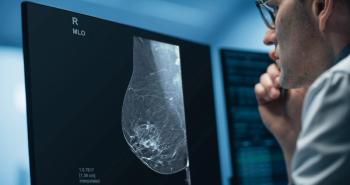
Q&A: Why is Breast Cancer Screening So Costly?
Coauthor of study discusses the costs of overdiagnosis and overtreatment of breast cancer.
The debate about the optimal screening guidelines for women at average risk of developing breast cancer continues, with some physicians supporting annual screening, starting at age 40, as advocated by the American Cancer Society and other organizations. While other physicians follow the U.S. Preventive Services Task Force
Arguments against annual screening focus on the risks related to concerns about overdiagnosis and management of certain types of breast cancer, which not only result in unnecessary treatments for patients, but also in extra financial costs overall.
In a
Diagnostic Imaging interviewed study coauthor Kenneth D. Mandl, MD, MPH, to learn more about the study and its findings. Mandl is a professor at Harvard Medical School and the Boston Children's Hospital Chair in Biomedical Informatics and Population Health.[[{"type":"media","view_mode":"media_crop","fid":"34886","attributes":{"alt":"Kenneth D. Mandl, MD, MPH","class":"media-image media-image-right","id":"media_crop_6502839203769","media_crop_h":"0","media_crop_image_style":"-1","media_crop_instance":"3714","media_crop_rotate":"0","media_crop_scale_h":"0","media_crop_scale_w":"0","media_crop_w":"0","media_crop_x":"0","media_crop_y":"0","style":"height: 185px; width: 200px; border-width: 0px; border-style: solid; margin: 1px; float: right;","title":"Kenneth D. Mandl, MD, MPH","typeof":"foaf:Image"}}]]
What do you see as an ideal breast cancer screening process that wouldn’t be as expensive as what we have now?
Part of the solution may be to lower the frequency of screening, to biennial instead of annual, for example. The U.S. Preventive Services Task Force recommended abandoning screening in women age 40 to 49, but the
The evidence to date may not support universal breast cancer screening of asymptomatic women. An intermediate approach is to adopt a personalized risk-based approach, rather than a population-based strategy. In other words, we should only screen women with high risk of breast cancer, for whom the benefit of screening outweighs the risk. These would include women who have a family history of breast cancer.
Is family history of breast cancer the only criteria for a personalized risk-based approach? What else would constitute high risk?
No, other risk factors should be taken into account. Risk factors that have been found to be associated with breast cancer include age, genetic risk factors (eg, BRCA1 and BRCA2), exposure to radiation therapy to the breast/chest, long-term use of hormone replacement therapy, and denser breasts.
What is your opinion of the Swiss Medical Board recommendation of abandoning mammography altogether? If we are only screening high-risk women, what modality do you propose be used?
The Swiss Medical Board recommends that population-based screening of asymptomatic women should be replaced by a more individualized approach. This is supported by existing evidence, and will substantially reduce the harms of false-positive mammograms and breast cancer overdiagnoses.
We should still use mammography but in a selected group.
This study looked at women aged from 40 to 59. Do you believe that there would be similar findings for women over 60 years?
False-positive mammograms and overdiagnosis rates are likely to be lower for women who are older than 60 years. Nonetheless, the risks remain and should be carefully considered.
How do you see the medical community containing the costs that are associated with breast screening and the outcomes?
Currently, it’s the fear of litigation and the lack of understanding of the harm screening could cause, as well as the biology of cancers, which are driving the overuse of screening technology.
In a recent effort to rein in breast cancer overdiagnosis and overtreatment, a working group from the National Cancer Institute suggested renaming ductal carcinoma in situ (DCIS) to exclude the word carcinoma. This, we hope, will help doctors and patients better understand the nature of DCIS, and to avoid what may be unneeded and potentially harmful treatments.
What is the status of the suggestion to remove carcinoma from DCIS?
DCIS remains widely used.
If lack of understanding of the harm is part of why breast cancer screening is so costly, what kind of harms exist that clinicians may not be aware of?
Many clinicians are unaware of the high rates of false-positive mammograms and breast cancer overdiagnoses, and that many lesions detected through mammography screening will not actually become clinically evident in the patient’s lifetime. Unfortunately, the widely used 5-year survival rate of cancer is misleading many clinicians into believing that mammography screening of asymptomatic women actually saves lives, as most clinicians are not aware of the concept of lead-time and length biases.
What would you say to someone who would counter that the costs associated with breast screening would be worth it because of the lives screening does save?
In our study, we only looked at refutable downsides of mammography-false positives and overdiagnoses. Other studies are increasingly concluding that the benefits may be very questionable. It is worth noting that with the initiation of population-based breast cancer screening in the U.S., breast cancer mortality rate has not substantially decreased.
Is it possible to quantify the lives saved from breast cancer screening versus the amount of money spent on these programs and on overdiagnosis?
You might look at the landmark study published in the
Newsletter
Stay at the forefront of radiology with the Diagnostic Imaging newsletter, delivering the latest news, clinical insights, and imaging advancements for today’s radiologists.




























